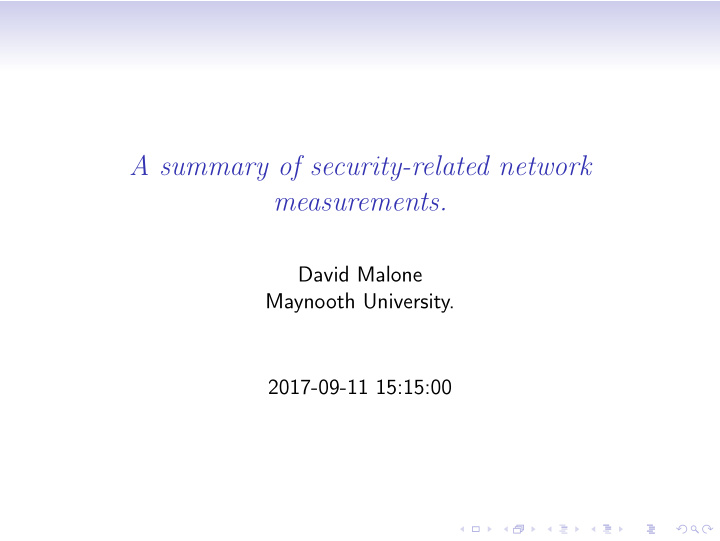



A summary of security-related network measurements. David Malone Maynooth University. 2017-09-11 15:15:00
Network Measurement Results • Internet Measurement Conference (IMC), • Passive and Active Measurement Conference (PAM), • Traffic Measurement and Analysis (TMA), • Also at SIGCOMM, Usenix Security, IEEE SS&P, NDSS, . . .
Packet Processing Frameworks • BPF • old, useful and new uses in Linux. • PF_RING • faster packet capture, • reduces copies, • better multithreading, queueing, hashing, . . . • DPDK/netmap • full packet processing in userland, • can write switches/firewalls/IDSes/. . . , • used to accelerate various tools. Form the basis for tcpdump, tshark, wireshark, . . . Some interesting extensions for other technology (e.g. radiotap for WiFi, usbdump for USB).
Scanning Tools • nmap • nc • zmap • Bit like nmap, • Focused on fast large-scale scanning, • Did a 65536 host network in 10s, • Whole IPv4 Internet in 5min (10Gbps + PF_RING) • Family of tools for: • zgrab for banner grabbing, • zdns for looking up DNS, • zcrypto/zlint/zcertificate for TLS/cert analysis. • Even a search engine https://censys.io • Some more advanced tools like scamper.
Measurement Infrastructure • Looking glasses, • Passive Network Telescopes • Unused but routed address space, • Look for direct attacks or reflected spoofed traffic, • e.g. UCSD (CAIDA) or Team Cymru Darknet. • Often used to monitor DDoS events. • RIPE Atlas, • (10,000) Small computer hosted in network, • Does pings/DNS lookups/. . . , • Allows used-defined measurements, • Encourages researchers to get involved. • CAIDA ARC, • Currently Raspberry Pi hosted by researchers, • Used for topology measurement, DNS measurements, . . . • Allows ping/traceroute interface for researchers. • Facebook ads.
IPv6 • Google sees about 20% users using IPv6, • Ireland at about 10% • Interest in mapping usage • Log files and traceroutes, • Akami mapping users, • Now interest in target generation (DNS walking, . . . ), • How to map open relays, proxies, resolvers, . . . • How to identify IPv4/IPv6 pairs, • Also interest in new protocol features (e.g. extension headers). Some studies of address scarcity and markets forming for IPv4.
Routing • Longstanding problem of measuring topology, • Some research on whose AS can see your packets, • Who is allowing spoofing (egress filtering)? • BGP studies of flapping, AS reputation, hijacking, • Some great databases of historical data, • Starting studies of RPKI. Related: DDoS measurement/mitigation, geolocation, ... Vaguely related: Spotting large scale network scans.
DNSSEC • How deployed is DNSSEC? • Server side: who signs, what algorithms, . . . ? • Client side: who verifies? • Deployment challenges. • EDNS0 extensions for large responses. • Switching to TCP. • Effectiveness of NSEC. • Measuring key rollover. Other DNS activity: detecting alternative roots, performance/robustness of anycast, . . .
TLS/SSL • Deployment levels have always been well monitored. • Performance has also been of interest. • Health of certificate system: • certificate transparency, • certificate validity (65% have problems), • Fascinating attacks on keys: • Debian RNG bug. • gcd ( N 1 , N 2 ) for RSA. • Resulting patching behavior. • Implementation problems • long session caching, • long Diffie-Hellman lifetimes, • clients presenting TLS certificates.
Network Censorship • Understanding the Great Firewall of China, • Measuring Internet disconnection around specific events, • Finding websites or pages that are blocked, • Finding content and keywords that are blocked. • People hiding protocols on wrong port/with TLS/with Tor. There’s a whole side subject or Tor deanonymisation. Has raised ethical issues.
Modern Mobile/App/Web Infrastructure • What are mobile operators middle boxes up to? • How trackable are you with TLS on? • How can we find personally identifying information? • How do apps behave? • How many are built evil? • How many apps/frameworks are calling home? • Are tracker blockers/ad blockers/cookie directives any good?
Interesting High Level Measurements • Deanonymisation of bitcoin transactions. • Analysis of propaganda/fake news bots. • Detecting and characterising doxing. • Who gets to see your e-mail? • What happens to stolen e-mail creds?
Recommend
More recommend